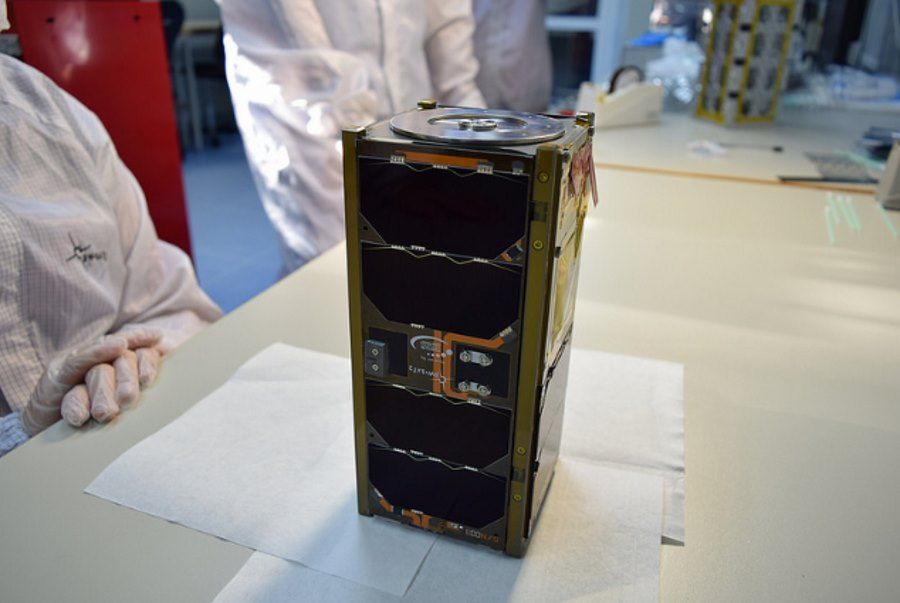
The mission of Poland’s PW-Sat2 satellite is coming to an end
Poland’s fourth PW-Sat2 satellite unfurled its deorbitation sail on December 29, 2018, just before 11 a.m.00. On command received from the ground station, the satellite launched the deorbit sail release mechanism. Moments later, operators analyzing the satellite’s telemetry data were able to confirm that the sail was successfully opened in space. This is confirmed by photos and time-lapse video of the sail opening sent from aboard the satellite. The PW-Sat2 satellite also took the first-ever Polish satellite photo.
After 9 o’clock.00, ground station operators (located at the Faculty of Electronics and Information Technology at Warsaw University of Technology and at the headquarters of Future Processing in Gliwice) established radio communication with the PW-Sat2 satellite to examine its current status and prepare for the execution of the głow of the mission experiment. Around poone and a half hours pos the satellite once again flew over Poland, another – one of the most important for the course of the entire mission – communication session began. The operators, after again ensuring that all key subsystems were operational, sent the command to launch the sail experiment, and the cameras on board began taking a sequence of images to record this crucial moment.
At 10:54 a.m., the telemetry transmitted from the satellite registered a change on the switch indicating the status of the mechanism holding the sail, as well as significant changes in the indications of the gyroscopeow – as expected, after opening the sail, the satellite began to rotate faster. During the third communication session of the morning, the following details were receivedohe satellite’s condition data from the time of the sail experiment, and one of the photos taken by the onboard camera, showing the unfolded deorbitation sail.
During the next several communication sessions, with the support of radio amateurow from around the world, was downloaded a sequence of photos taken during the head of theoThe success of the experiment. The video below shows the behavior of the deorbitation sail just after ejection from the tank placed on the PW-Sat2 satellite. The photos were taken at 5-second intervals.
– We managed to carry out all the planned experiments. We feel proud to have achieved our goals. This is a particularolny moment also because it marks the end of the mission and the end of the life of PW-Sat2, whichory will burn up in the atmosphere within several months. But it gives roalso hope that the idea of Polish engineersow for deorbitation of satellitesow will be mohead to be used successfully on other devices of this type placed in space,” said Dominik Roszkowski, deputy coordinator of PW-Sat2.
– Congratulations to all whooers have earned this success. I am glad to see that FP engineers are also included in this group, ktoers engaged in the project out of pure passion. Space exploration is for dreamers and today is our holiday – mowi Jarosław Czaja, CEO of Future Processing, strategic partner of the PW-Sat2 project.
The arms of the deorbitation sail are made of flat springs placed in robust mylar pockets. The stored elastic energy allows the sail to unfurl after release from the tray, and their shape allows them to remain rigid and stable even under normal Earth gravity conditions. The arms are arranged on the diagonals of the sail and, thanks to their small dimensions, allow the diameter of the rolled up sail to not exceed 8.5 cm.
The initial mission plan called for the opening of the deorbit sail 40 days after the PW-Sat2 satellite was placed in orbit. However, already after 20 days, i.e. in the middle of the mission, all the previously assumed “pre-sail” goals. Many experimentow have been launched more times than planned. On the decision to accelerate the execution of the headoThe growing risk of losing the satellite also had an impact on the experiment. Objects placed in space are exposed to cosmic radiation, whichore poses a huge threat, headonotably for electronics. Each successive day increases the risk of system-threatening failures, ktore can be irreversible in their effects.
Along with the opening of the composite sailoThe project has entered its final phase. In the following days, ground station operators will try to maintain communications with the satellite and receive as much data as possible on its condition. The large size of the sail makes it difficult to harvest solar energy, so the satellite is expected to lose communications and terminate operations. Glohowever, the primary task of this phase is to observe the degradation of PW-Sat2’s orbit. This will be implemented on the basis of ogolnodible radar data from the NORAD database, the same through which theohe ground stations were able to track the satellite’s position in the sky beforehand. The available data include the parameters of the orbit, with whichowhich it is possible to read, among other things, the height of the object’s flight. Such tracking will be carried out for the next several months or so, until the PW-Sat2 object disappears from radarow, which will rotantamount to complete burnout in gohe different layers of the atmosphere. The course of the orbit descent and the time of deorbitation will be cfownana with previously performed analyses. This will make it possible to determine what the actual effectiveness of such a deorbit solution was.
The conducted mission proved to be quite a success for the student teamoThe Warsaw University of Technology. The test of deorbit sail technology they have prepared can helpoc in effectively confronting the problems resulting from the increase in the number of objectsoin placed in orbit around the Earth. PW-Sat2 experienced a close flyby of an inoperable object at a distance of 79 meters during its missionow. In the course of just 20 days, the nanosatellite was already at risk of collision. This type of situation for larger satellitesow occur much more frequently. This event perfectly demonstrates why the PW-Sat2 mission is important and the problem of space junk so topical.


